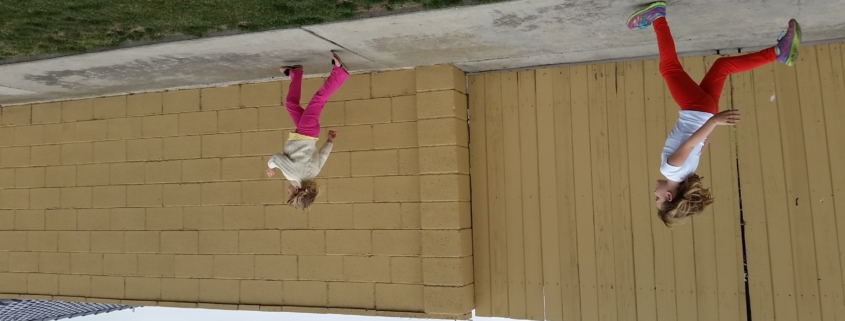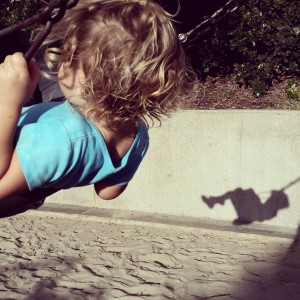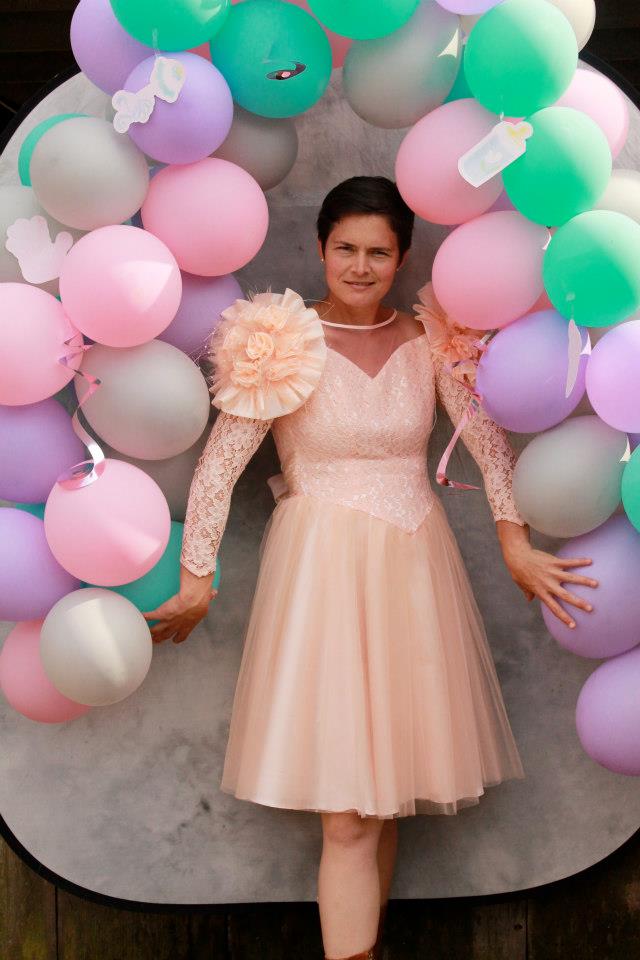Note to Self
When I was pregnant with my first daughter, my social media photostream underwent the (irritating, irrepressible) transition from Normal Adult Feed to Prenatal and, then, Child-Rearing Feed. There was a lot going on. Life in my postpartum body treated me to some surprises and some alarming changes. I couldn’t do Zumba without peeing my pants a little, for example. I took up Zumba, as another example. Clumps of my hair fell out. Later, it came back. These things were described to me as normal. You had a baby. Bring extra panties.
There were other, more subtle, changes for which naturally occurring oxytocin, also named the “love drug,” was largely to blame. Oxytocin is a hormonal cocktail that causes normal people to stare at their child for hours, never bored, rarely blinking, scarcely believing. Before I had children, I was a sort of caustic non-hugger who only admitted to feeling emotions when persuaded by bourbon. Just hours before my daughter’s birth, when my husband crouched next to me in the warm birthing tub and said how much he loved me, with my eyes shut, I replied, “I have really mixed feelings about you right now.”
But then my daughter popped out (not the exact verb, but I’ll spare you) and in the moments after her birth I found myself totally inarticulate. This remains the most unutterable sequence of my life. I was a swollen, snotty, tear-smeared fool with no hope for a witty rejoinder. There is a mercifully non-high-def video to prove it. When it came to the unprecedented explosion of love, my mind was full of light, not words. I was hormone drunk, gaping soundless as a fish.
* * *
Writers have lots of choices when they arrange a meaningful scene, but I’ve become fixated on the option of silence. During the MFA residency in June, author and Antioch faculty mentor Brad Kessler gave a lecture on the effective use of silence in literature. He gave examples of authors who write speech-less moments, sometimes to articulate the transcendent or the uncanny. A girl spots a ghost on the moor. A man looks up a flight of stairs and sees his wife anew. A woman prepares dough for bread. He said a lot that I can’t pretend to paraphrase, except to repeat this: Writers and readers meet on the page in moments of ineffable stillness.
There’s a lot of discussion in writing programs about showing versus telling. If we trust ourselves as writers and if we trust those who read us, we won’t fill pages with superfluous exposition and ready-made feeling. If we get it right on details and observation, a connection will be forged between the author and the reader. Among the phenomena that resist description is love, and yet we use words to triangulate a meaning. We can’t resist trying. I’m attempting to learn to write with precision and care in order to be truthful, sometimes about the unspeakable. I am here to confess that I’ve been slacking on the matter of trust.
* * *
Facebook was apprised within an hour of my child’s sacred arrival. I started snapping pictures right away because it was the only thing I could think to do. Soon I discovered Instagram. Now my pictures go to Facebook via Instagram. The last time this happened was earlier today. My daughter had, on impulse, penciled a short note about her love for me. Her hand at printing is still unsure. She pressed very hard into the paper, was unsatisfied with the writing and erased it vigorously. She wrote her note over again and then, satisfied with her straight lines, presented the gift to me. I read it back to her as she sat in the bathtub with a washcloth draped over her head. Her face was rosy and embarrassed. I thanked her and then I raised my phone and took a picture of the note and my girl.
The compulsion to post pictures is not shared by all. My own husband is not on Facebook. But quite a few folks—there are 300 million active monthly users of Instagram—do feel compelled to share. Some parents post pictures of their kids in order to keep far-flung relatives apprised of baby progress. My own in-laws live in Kansas. They don’t get to see my kids as often as they’d like. The “good” news for them is that, in the three years since downloading Instagram, I have posted 1,020 pictures. Approximately 90% of these are pictures of my two daughters. I just checked. And yes, the numbers make me as uncomfortable as you think they should. I’m not here to comment about social media/narcissism/the selfie polemic in any general sense. What’s important is the problem of my artistic cop-out.
In a recent NPR interview, George Pelecanos talks about his ritual of riding his bike around, photographing people and locations so that he can use them in his stories. At home, he reviews the pictures to get the details right. This struck me as a useful tool. But I am not using pictures as useful means to an end. To be honest, I’m not even that concerned about updating relatives. Raising my phone has become a knee-jerk response to the sublime.
Susan Sontag expressed some very pointed, prescient notions about the photographic medium when she wrote “In Plato’s Cave,” the first essay in her collection On Photography. When she published the piece in 1977, Sontag lamented the advent of “sleek pocket cameras that invite anyone to take pictures.” I just read the essay on my smart phone, the one with 800 pictures still stored in memory. Earlier today I watched Michael Jackson dance to Billie Jean on it. I typed part of this blog post into my phone’s Google Docs app. Applying Sontag’s arguments to the 2015 social media scenario is not a task I can ably attack here, but I will venture that her ideas still apply: “Needing to have reality confirmed and experience enhanced by photographs is an aesthetic consumerism to which everyone is now addicted.” One-thousand-twenty pictures later, yes, I’d say addiction is something I might be dealing with. She also talks about photography producing a semblance of subject, not the truth of the subject itself. And: “Most tourists feel compelled to put the camera between themselves and whatever is remarkable that they encounter. Unsure of other responses, they take a picture. This gives shape to experience: stop, take a photograph and move on.” Unsure of other responses, indeed. Mind blown, in an oxytocin-induced stupor, for example.
I am not a trained photographer. I have a vague notion that a shutter is something like an eyelid that opens to admit light. But the Instagram application offers enough clever effects to make even the meanest Android fumbler occasionally feel like Stieglitz. Here is where the danger arises. Maternal love has got me in its hormonal tether and it’s the subject on which I manage the least writerly traction. When my heart starts to ache, I snap a picture. I crop it. I scroll through an array of available filters to cast sentiment on it. I use a canned trick of light. The moment has been described, so I send it into the Internet in a plea for connection.
I’ve been using the act of posting pictures to social media as a placeholder for something so far unspeakable. An Instagram filter is mood bought cheap, and I should be wary of the bad bargain, because often the truth of my love is on the line. We write to make some sense or connection or both. You deliver a baby at 2:30 p.m. on a hot August Friday and your whole world splits apart. What enters is blinding bright and unfiltered. A midwife sets your daughter’s curled, purplish body on your breast. Your face crumples up in an odd mirror of your baby’s. Five years later that daughter is moved to write you a note about love.
Unspeakable things are difficult to articulate, but not always impossible. In his lecture, Mr. Kessler gave examples of masters who succeeded–through sequences of silence, through moments of apt detail, close observation and care–in communicating the preternatural. What halts me in describing life’s fraught moments is mistrusting my ability to get it right, and not trusting the reader to come along if I try. I’m discounting the reader’s aptitude for filling the silence with their own important meaning. This is a mistake, because every time I slap a filter on something instead of plumbing the deep vocabulary of silence, I miss a chance for communion. Because, as it turns out, I am not the first mother to love her child.
Mary Birnbaum is editor of Lunch Ticket’s Diana Woods Memorial Prize in Nonfiction. She holds an MFA from Antioch. She has contributed to Lunch Ticket and The Week. Mary was the 2018 recipient of Disquiet International’s Nonfiction Fellowship and a finalist for Chattahoochee Review’s Lamar York Prize. She resides in Vista, California with her daughters and husband. If you like, you can find her on Twitter @ailishbirnbaum








